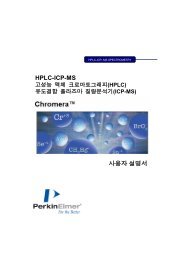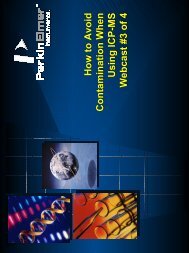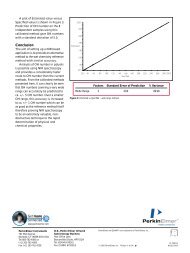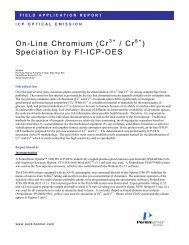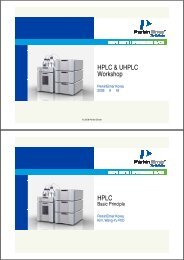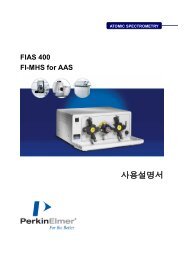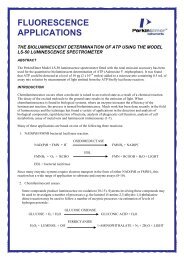expanding the capabilities of ICP-MS
expanding the capabilities of ICP-MS
expanding the capabilities of ICP-MS
You also want an ePaper? Increase the reach of your titles
YUMPU automatically turns print PDFs into web optimized ePapers that Google loves.
<strong>expanding</strong> <strong>the</strong><br />
<strong>capabilities</strong> <strong>of</strong> <strong>ICP</strong>-<strong>MS</strong><br />
ELAN DRC-e
setting a new standard<br />
in <strong>ICP</strong>-<strong>MS</strong> performance<br />
When your applications extend beyond <strong>the</strong> <strong>capabilities</strong><br />
<strong>of</strong> conventional quadrupole <strong>ICP</strong>-<strong>MS</strong>, you need <strong>the</strong><br />
power <strong>of</strong> <strong>the</strong> innovative ELAN ® DRC-e. The DRC-e<br />
brings <strong>the</strong> interference-eliminating power <strong>of</strong> patented<br />
Dynamic Reaction Cell (DRC) technology and<br />
performance-enhancing Axial Field Technology (AFT)<br />
to <strong>the</strong> industry-proven ELAN <strong>ICP</strong>-<strong>MS</strong> system. The<br />
result is uncompromised sensitivity and performance<br />
in a robust system designed for routine laboratories.<br />
The ELAN DRC-e uses chemical resolution to eliminate<br />
plasma-based polyatomic species before <strong>the</strong>y reach <strong>the</strong><br />
quadrupole mass spectrometer. This ion-molecule<br />
chemistry uses a reaction gas to “chemically scrub”<br />
polyatomic or isobaric species from <strong>the</strong> ion beam before<br />
<strong>the</strong>y enter <strong>the</strong> analyzer, resulting in improved detection<br />
limits for traditionally difficult elements, including As,<br />
Cr, Fe, Se and o<strong>the</strong>rs. And, unlike collision-cell, highresolution<br />
or cool-plasma systems, <strong>the</strong> ELAN DRC-e<br />
system eliminates not only <strong>the</strong> primary interference; but<br />
also prevents <strong>the</strong> formation <strong>of</strong> new interferences, while<br />
maintaining analyte sensitivity – providing ultratracelevel<br />
detection limits in virtually any matrix.<br />
Combined with a robust HF-resistant sample introduction<br />
system and <strong>the</strong> purpose-designed productivityenhancing<br />
features <strong>of</strong> <strong>the</strong> ELAN <strong>ICP</strong>-<strong>MS</strong> system, <strong>the</strong><br />
maintenance-free Dynamic Reaction Cell provides<br />
a system with uncompromised performance that is<br />
rugged, reliable and easy to use – a must for today’s<br />
high-throughput production environments.<br />
Superior detection <strong>capabilities</strong><br />
The superior interference reduction and maximum<br />
analyte transmission provided by <strong>the</strong> ELAN DRC-e<br />
produces excellent signal-to-background ratios. Background<br />
levels measured on-peak are typically less than<br />
1 count per second – 50 to 150 times better than those<br />
reported by users <strong>of</strong> collision-cell based systems.<br />
The ELAN DRC-e does not use high-voltage ion-extraction<br />
lenses that can become contaminated. This results<br />
in lower on-peak background levels and more importantly,<br />
a lower background equivalent concentration<br />
(BEC) – <strong>the</strong> real measure <strong>of</strong> detectability. If <strong>the</strong> signal<br />
falls below <strong>the</strong> BEC, it is masked by <strong>the</strong> background.<br />
In situations where ultratrace measurements are made,<br />
<strong>the</strong> BEC actually limits <strong>the</strong> analysis, not <strong>the</strong> detection<br />
limit. Lower BECs mean that ultratrace levels can be<br />
accurately quantitated, not just detected.<br />
SimulScan<br />
Simultaneous<br />
dual-stage detector<br />
with 9 orders <strong>of</strong><br />
dynamic range<br />
DRC with Dynamic<br />
Bandpass Tuning<br />
Efficiently screens<br />
out interferences<br />
while maximizing<br />
analyte transmission<br />
PlasmaLok<br />
Easy optimization and<br />
extended cone life<br />
Robust HF-resistant<br />
Sample Introduction<br />
System<br />
Maximizes<br />
productivity<br />
Axial Field<br />
Technology<br />
Optimizes<br />
performance<br />
and speed in<br />
all matrices<br />
AutoRes<br />
Custom resolution minimizes<br />
spectral interferences and<br />
improves detection limits<br />
High-speed Quadrupole<br />
Fast transient-signal analysis<br />
Nickel<br />
Quick-change<br />
Interface Cones<br />
Easy maintenance,<br />
maximum uptime<br />
AutoLens<br />
Optimizes voltage<br />
for each element<br />
Dynamic Reaction Cell (DRC)<br />
with Axial Field Technology<br />
provides superior interference<br />
removal and performance for<br />
all applications.<br />
2
eliminates interferences<br />
for superior performance<br />
How does <strong>the</strong> DRC work?<br />
The DRC is located between <strong>the</strong> ion optics and <strong>the</strong> massanalyzer<br />
quadrupole. It consists <strong>of</strong> a quadrupole placed<br />
inside an enclosed reaction chamber. This quadrupole<br />
eliminates polyatomic interferences caused by <strong>the</strong> combination<br />
<strong>of</strong> plasma gases and sample-matrix constituents<br />
before <strong>the</strong>y can enter <strong>the</strong> analyzing quadrupole.<br />
Gas inlets pressurize <strong>the</strong> reaction chamber with a low<br />
flow <strong>of</strong> reaction gas, such as methane, oxygen, carbon<br />
dioxide or o<strong>the</strong>r gases and gas mixtures. The reaction gas<br />
is selected based on its predictable ability to undergo a<br />
gas-phase chemical reaction with <strong>the</strong> interfering species<br />
and remove <strong>the</strong> interference. Interference removal can<br />
occur through various processes, including collisional<br />
dissociation, electron transfer, proton transfer and oxidation.<br />
Analyte and interfering ions from <strong>the</strong> <strong>ICP</strong> enter<br />
<strong>the</strong> DRC. The reaction gas combines with <strong>the</strong> interfering<br />
ions, creating a non-interfering reaction product at a<br />
different mass. For extremely demanding applications,<br />
<strong>the</strong> DRC also provides <strong>the</strong> unique ability to carry out<br />
controlled reactions that can be used to predictably and<br />
reliably convert <strong>the</strong> analyte <strong>of</strong> interest to a different<br />
species, moving it away from <strong>the</strong> interference. No o<strong>the</strong>r<br />
system <strong>of</strong>fers this level <strong>of</strong> predictable, controllable,<br />
reproducible or transferable chemistries, facilitating<br />
maximum interference removal in virtually any matrix.<br />
Unlike collision-cell instruments, which pass all <strong>the</strong> reaction<br />
products into <strong>the</strong> analyzer quadrupole where <strong>the</strong>y<br />
may cause interferences for o<strong>the</strong>r analytes, <strong>the</strong> DRC eliminates<br />
reaction by-products using <strong>the</strong> Dynamic Bandpass<br />
Tuning (DBT) mechanism. The DBT function ejects <strong>the</strong><br />
precursor ions before <strong>the</strong>y can react to form new interferences<br />
– a real concern with complex sample matrices.<br />
The ELAN DRC-e is able to eliminate interferences by<br />
up to 9 orders <strong>of</strong> magnitude, while retaining analyte<br />
sensitivity. This provides exceptional detection limits<br />
and <strong>the</strong> ability to use <strong>ICP</strong>-<strong>MS</strong> to determine more elements<br />
than previously thought possible.<br />
Leaves cool plasma out in <strong>the</strong> cold<br />
DRC technology always uses a high-temperature or<br />
“hot” plasma for analysis, eliminating <strong>the</strong> recognized<br />
drawbacks <strong>of</strong> cool- or warm-plasma approaches. Coolertemperature<br />
plasmas have limited ability to ionize all<br />
but <strong>the</strong> most easily ionizable elements. As a result,<br />
cool plasmas also suffer from severe suppression <strong>of</strong> <strong>the</strong><br />
analyte signal by matrix constituents and <strong>of</strong>ten require<br />
<strong>the</strong> use <strong>of</strong> standard additions calibration. This decreases<br />
sensitivity and degrades detection limits for elements<br />
with high ionization potentials and limits <strong>the</strong> number<br />
<strong>of</strong> interferences that can be removed.<br />
Using <strong>the</strong> cool-plasma approach, elements which benefit<br />
from cool-plasma conditions must be run in a separate<br />
analysis from normal plasma elements, requiring<br />
each sample to be run twice. The ELAN DRC-e can run<br />
all <strong>the</strong>se elements in <strong>the</strong> same run, increasing productivity.<br />
And, <strong>the</strong> ELAN DRC-e provides interference-free<br />
determination <strong>of</strong> elements that cold plasma cannot,<br />
such as As, Cr and Se. Plus, DRC technology works in<br />
any matrix, eliminating <strong>the</strong> complicated matrix-reducing<br />
sample-preparation procedures <strong>of</strong>ten required for<br />
matrices such as hydrochloric acid when run under<br />
cool-plasma conditions.<br />
Reaction Cell<br />
Quadrupole<br />
Reaction<br />
Gas Inlet<br />
Mass Analyzer<br />
Quadrupole<br />
Reaction gas “scrubs<br />
out” interferences<br />
Analyte Ion<br />
Isobaric Interference<br />
The Dynamic Reaction Cell chemically scrubs interfering species from<br />
<strong>the</strong> ion beam using a reaction gas.<br />
The ELAN DRC is <strong>the</strong> only system that can eliminate CaOH+ interference<br />
on 60 Ni – eliminating false positives in high-calcium matrices.<br />
www.perkinelmer.com 3
unequaled performance<br />
for routine analyses<br />
In addition to eliminating interferences in traditionally<br />
difficult-to-determine elements, <strong>the</strong> ELAN DRC-e system<br />
has been specifically designed for high-throughput analyses,<br />
providing a new level <strong>of</strong> performance for <strong>ICP</strong>-<strong>MS</strong>.<br />
The ELAN DRC-e utilizes a rugged and reliable HFresistant<br />
sample introduction system that has been field<br />
proven in over 2000 laboratories. The cross-flow<br />
nebulizer handles a wide variety <strong>of</strong> sample matrices and<br />
is virtually maintenance-free, providing trouble-free<br />
operation. The open architecture design makes switching<br />
to different sample introduction devices quick and<br />
simple. The ELAN DRC-e can utilize a variety <strong>of</strong> alternate<br />
sampling devices, including laser ablation, ultrasonic<br />
or low-flow nebulization systems or even liquid- or<br />
ion-chromatography systems for speciation analysis.<br />
The unique single-ion lens simplifies operation with<br />
automatic optimization and specific on-<strong>the</strong>-fly mass<br />
settings for each element, minimizing undesirable<br />
space-charge effects that can lead to signal and<br />
performance loss. The ELAN DRC-e has unequaled<br />
detection limits, BECs, specificity and sensitivity,<br />
as well as a robust and trouble-free design – all<br />
requirements for <strong>the</strong> busy laboratory.<br />
Axial Field Technology maximizes<br />
performance for all matrices<br />
Innovative Axial Field Technology, developed specifically<br />
for <strong>ICP</strong>-<strong>MS</strong>, applies a linearly accelerating axial<br />
field to <strong>the</strong> ions inside <strong>the</strong> Dynamic Reaction Cell. This<br />
technology decreases matrix effects, improves stability<br />
and increases <strong>the</strong> speed <strong>of</strong> <strong>the</strong> DRC. This makes <strong>the</strong><br />
ELAN DRC-e <strong>the</strong> ultimate analytical tool for all applications<br />
including environmental and geochemical, where<br />
optimal performance in challenging matrices is required.<br />
Collisional focusing provides improved<br />
sensitivity and precision<br />
The ELAN DRC-e <strong>of</strong>fers exceptional sensitivity and stability.<br />
Using collisional focusing (Figure 1), sensitivity<br />
can be enhanced by up to 5 times, when compared to<br />
a standard <strong>ICP</strong>-<strong>MS</strong> system.<br />
Collisions with <strong>the</strong> reaction gas allow ions to spend more<br />
time in <strong>the</strong> DRC, reducing short-term signal fluctuations.<br />
This lowers plasma noise, leading to improvements in<br />
short-term precision.<br />
This excellent short-term precision dramatically improves<br />
isotope-ratio measurements performed on <strong>the</strong><br />
ELAN DRC-e. Relative standard deviations for isotope<br />
ratios <strong>of</strong> less than 0.03% are routinely achievable.<br />
Intensity<br />
After DRC<br />
Collisional Focusing<br />
Direction <strong>of</strong> ion travel<br />
Ion Distribution<br />
Before DRC<br />
Figure 1. In <strong>the</strong> DRC, <strong>the</strong> ions collide with <strong>the</strong> reaction gas, causing<br />
<strong>the</strong>m to lose energy and focus <strong>the</strong>ir motion on axis. This allows <strong>the</strong><br />
ions to spend more time in <strong>the</strong> DRC, reducing short-term signal<br />
fluctuations. This collisional energy damping reduces <strong>the</strong> energy<br />
spread, while collisional focusing (migration <strong>of</strong> ions towards <strong>the</strong><br />
quadrupole axis) results in improved ion transmission and sensitivity.<br />
DRC gets <strong>the</strong> right answer, faster<br />
Unlike “cool plasma” and high-resolution analyses<br />
where optimization <strong>of</strong> analytical conditions is done for<br />
each analyte and multiple runs are required to determine<br />
several analytes, <strong>the</strong> ELAN DRC-e removes multiple<br />
interferences during <strong>the</strong> same analytical run. The<br />
ELAN DRC-e significantly improves productivity by<br />
reducing <strong>the</strong> number <strong>of</strong> runs required. You can combine<br />
different sets <strong>of</strong> DRC conditions for different elements<br />
in <strong>the</strong> same analytical method along with conditions<br />
for elements run in standard mode, providing faster,<br />
more accurate results.<br />
4
controlled, predictable chemistry<br />
maximizes interference removal<br />
Dynamic Bandpass Tuning<br />
Unlike o<strong>the</strong>r systems that use rf-only hexapoles and<br />
octapoles as simple ion guides, <strong>the</strong> quadrupole used in<br />
<strong>the</strong> patented DRC technology provides both high- and<br />
low-mass cut<strong>of</strong>fs – defining a precise mass bandpass<br />
window. The mass bandpass window ejects all ions<br />
with masses outside <strong>the</strong> window before <strong>the</strong>y can react<br />
inside <strong>the</strong> DRC, preventing <strong>the</strong> formation <strong>of</strong> new interferences.<br />
The bandpass window is selected via <strong>the</strong><br />
automated setup procedures based on <strong>the</strong> specific<br />
chemistry that needs suppression or promotion. And,<br />
since a specific bandpass range can be selected for<br />
each analyte, <strong>the</strong> bandpass filter can be dynamically<br />
tuned to best suit <strong>the</strong> analyte <strong>of</strong> interest. As a result,<br />
species falling outside <strong>of</strong> <strong>the</strong> analytical bandpass are<br />
completely eliminated, preventing <strong>the</strong> formation <strong>of</strong><br />
new species and possible interferences (Figure 2).<br />
In contrast, competitive systems use energy filtering,<br />
which only allows new interferences to be reduced<br />
after <strong>the</strong>y are formed. This restricts interference removal,<br />
since <strong>the</strong> number <strong>of</strong> collisions in o<strong>the</strong>r systems must be<br />
limited in order to maintain a sufficient kinetic-energy<br />
spread between <strong>the</strong> analyte and interfering species for<br />
<strong>the</strong> filter to be effective. And, since energy filtering is<br />
non-selective, both interferent and analyte intensities<br />
are reduced.<br />
DBT optimizes chemical specificity<br />
Differentiation between <strong>the</strong> analyte and an interfering<br />
species is critical to success in <strong>ICP</strong>-<strong>MS</strong>. The ELAN DRC-e<br />
provides greater accuracy by eliminating false positives<br />
due to interferences. The presence <strong>of</strong> an isobaric or<br />
molecular interference can lead to an elevated signal at<br />
<strong>the</strong> analyte mass. For example, ArCl + and CaCl + are two<br />
molecular species that interfere with arsenic determinations<br />
at mass 75. In some cases, <strong>the</strong>se interferences<br />
are extremely difficult to resolve, ei<strong>the</strong>r because <strong>the</strong><br />
analyte is monoisotopic (such as in <strong>the</strong> case <strong>of</strong> arsenic)<br />
or <strong>the</strong> interference is too large.<br />
While o<strong>the</strong>r cell systems can partially remove some<br />
plasma-based interferences such as <strong>the</strong> ArCl + interference<br />
on 75 As + , <strong>the</strong>y are limited in <strong>the</strong>ir ability to remove<br />
many matrix-based interferences, such as <strong>the</strong> CaCl +<br />
interference on 75 As + . In contrast, <strong>the</strong> ELAN DRC-e<br />
allows <strong>the</strong> interference to be removed, whe<strong>the</strong>r plasmaor<br />
matrix-based, giving you confidence that <strong>the</strong> correct<br />
results for <strong>the</strong> analyte and not a matrix interference are<br />
reported. Using <strong>the</strong> ELAN DRC-e, molecular interferences<br />
that have plagued trace-level determination <strong>of</strong><br />
many elements by <strong>ICP</strong>-<strong>MS</strong> can be completely eliminated.<br />
Also, <strong>the</strong> superior specificity achieved with <strong>the</strong> ELAN<br />
DRC-e through <strong>the</strong> use <strong>of</strong> Dynamic Bandpass Tuning<br />
means reaction by-products are eliminated, preventing<br />
new interferences from forming. Left unchecked in all<br />
o<strong>the</strong>r systems, <strong>the</strong>se by-products produce new interferences,<br />
which must be reduced by increasing <strong>the</strong> kineticenergy<br />
filter – leading to additional analyte signal loss.<br />
Method development on <strong>the</strong> ELAN DRC-e using <strong>the</strong><br />
powerful ELAN s<strong>of</strong>tware is now easier than ever. Use<br />
one <strong>of</strong> our developed methods and you will be up<br />
and running quickly. For more unique applications,<br />
automated procedures determine <strong>the</strong> best reaction-gas<br />
flow conditions and DBT settings, making <strong>the</strong> system<br />
easy to use. Unlike o<strong>the</strong>r cell instruments, where reaction-gas<br />
selection must be restricted in order to reduce<br />
formation <strong>of</strong> reaction by-products, <strong>the</strong> ELAN DRC-e<br />
allows you to use a variety <strong>of</strong> reaction gases for interference<br />
removal. The ability to use more reactive gases<br />
including CH 4<br />
, O 2<br />
, N 2<br />
O and o<strong>the</strong>rs provides superior<br />
interference reduction and improved detection limits in<br />
a wide variety <strong>of</strong> sample types.<br />
Only <strong>the</strong> analyte ions<br />
pass through <strong>the</strong><br />
analyzer quadrupole.<br />
Direction <strong>of</strong> ion travel<br />
Dynamic Bandpass Tuning<br />
(DBT) ejects unwanted<br />
reaction products – preventing<br />
interferences with<br />
o<strong>the</strong>r analytes.<br />
Figure 2. In this example, <strong>the</strong> DRC removes <strong>the</strong> Ar 2<br />
+ interference<br />
by converting it to neutral Ar and CH x<br />
+ using methane as <strong>the</strong><br />
reaction gas.<br />
www.perkinelmer.com 5
proven technology<br />
and innovative design<br />
Not only does <strong>the</strong> ELAN DRC-e include <strong>the</strong> industry’s<br />
most effective method <strong>of</strong> eliminating interferences – it<br />
features a wealth <strong>of</strong> proven <strong>capabilities</strong> that make it<br />
superior to o<strong>the</strong>r <strong>ICP</strong>-<strong>MS</strong> systems.<br />
• Quick-change cones – The nickel-based interface<br />
cones have large diameter orifices (1.1 mm sampler<br />
and 0.9 mm skimmer) to resist clogging and signal<br />
drift. The easy-in, easy-out design makes routine<br />
maintenance simple and easy. Platinum cones are<br />
available as an option for increased matrix tolerance.<br />
• Patented PlasmaLok technology – Secondary<br />
discharges between <strong>the</strong> <strong>ICP</strong> torch and <strong>the</strong> interface<br />
cones can lead to signal drift and high background<br />
levels. PlasmaLok ® technology essentially eliminates<br />
<strong>the</strong> possibility <strong>of</strong> secondary discharges, extending<br />
cone life, reducing background signal levels and<br />
stabilizing ion-energy distributions. As a result,<br />
switching between plasma conditions and sample<br />
matrices, including aqueous, organic and dry aerosols,<br />
is virtually transparent, with no special optimization<br />
required or consumable parts to replace.<br />
• Simple, effective Shadow Stop technology – The ion<br />
optics in <strong>the</strong> ELAN were designed specifically for<br />
<strong>ICP</strong>-<strong>MS</strong>. Instead <strong>of</strong> bending <strong>the</strong> ion beam numerous<br />
times using complex multi-component lens systems<br />
to prevent uncharged species from entering <strong>the</strong> quadrupole,<br />
<strong>the</strong> ELAN DRC-e uses a simple, grounded<br />
Shadow Stop. The result is minimal maintenance and<br />
<strong>the</strong> elimination <strong>of</strong> tedious ion-tuning adjustments<br />
required by o<strong>the</strong>r systems as lens components and<br />
cells become contaminated, causing resistivity<br />
changes and requiring subsequent tuning changes.<br />
Since it is grounded, <strong>the</strong> Shadow Stop never needs to<br />
be optimized or cleaned to maintain its performance.<br />
• The industry’s only single ion lens – Designed<br />
specifically for <strong>ICP</strong>-<strong>MS</strong>, <strong>the</strong> unique SwiftMount<br />
single ion lens used on <strong>the</strong> ELAN systems provides<br />
worry-free operation. Protected by <strong>the</strong> Shadow Stop,<br />
cleaning requirements for <strong>the</strong> SwiftMount lens are<br />
also minimized. In contrast, complex competitive<br />
systems may have as many as 30 to 40 pieces in <strong>the</strong><br />
ion-optic system – making <strong>the</strong>m time-consuming to<br />
clean and reassemble. Unlike <strong>the</strong>se competitive<br />
systems, changing <strong>the</strong> exclusive SwiftMount ion<br />
lens on <strong>the</strong> ELAN <strong>ICP</strong>-<strong>MS</strong> is as easy as changing a<br />
light bulb. In fact, <strong>the</strong> process takes just a few minutes.<br />
And, since <strong>the</strong> SwiftMount lens is so economical,<br />
when it does need to be cleaned you can<br />
simply swap <strong>the</strong> dirty lens for a spare and clean <strong>the</strong><br />
dirty lens while your samples are being processed.<br />
This maximizes system productivity – an important<br />
requirement in high-throughput labs.<br />
• The industry’s only scanning, single ion lens with<br />
AutoLens one-touch adjustment – Not only does it<br />
optimize itself at <strong>the</strong> click <strong>of</strong> a button, <strong>the</strong> unique<br />
SwiftMount single ion lens optimizes automatically<br />
for each specific mass – providing <strong>the</strong> best possible<br />
sensitivity for each analyte, at all times. In contrast,<br />
competitive systems must be tuned on a single midmass<br />
element, compromising analyte sensitivity and<br />
require frequent tuning as ion-lens settings change<br />
over time.<br />
Figure 3. The new Build Run List feature will automatically build an<br />
exact listing <strong>of</strong> all your standards, quality-control checks and samples<br />
before you start your automated analysis – eliminating unexpected<br />
sample-run orders and errors.<br />
6
superior productivity<br />
and reliability<br />
www.perkinelmer.com 7<br />
• Integrated peristaltic pump with tubing saver –<br />
The sample introduction system uses an integrated<br />
peristaltic pump to dramatically reduce sampleuptake<br />
time. The tubing-saver feature ensures<br />
optimum measurement precision and prolongs<br />
peristaltic tube lifetimes.<br />
• Simultaneous dual detector – The SimulScan dualstage<br />
detector measures both high- and low-level<br />
analytes simultaneously. This conserves valuable<br />
or limited samples, eliminates <strong>the</strong> need to perform<br />
time-consuming sample dilutions and allows you<br />
to quickly identify uncharacterized samples.<br />
• Powerful ELAN s<strong>of</strong>tware – Whe<strong>the</strong>r your lab performs<br />
qualitative, semi-quantitative, quantitative or specialized<br />
analyses such as isotope-ratio, isotope-dilution<br />
or even speciation analyses, <strong>the</strong> powerful ELAN<br />
s<strong>of</strong>tware has all <strong>the</strong> features you need.<br />
Priority samples, flexible quality-control checks,<br />
transient-signal handling, speciation analysis, runlist<br />
build and customizable reporting are just a few <strong>of</strong><br />
<strong>the</strong> features that will make your life easier (Figure 3).<br />
Plus, integrated maintenance videos and our new<br />
PathFinder HTML-based Help will make routine<br />
tasks even easier (Figure 4). And, if you’re in a highly<br />
regulated environment, our Enhanced Security<br />
s<strong>of</strong>tware provides all <strong>the</strong> features you need to<br />
comply, even with 21 CFR Part 11 requirements.<br />
• The SmartTune s<strong>of</strong>tware wizard automatically sets<br />
up all your tuning procedures, runs <strong>the</strong>m in <strong>the</strong> sequence<br />
you select and prints out a final tuning report<br />
based on user-selected pass/fail criteria (Figure 5).<br />
The result is effortless operation, all day, every day.<br />
Figure 4. PathFinder HTML-based Help will guide you step-by-step<br />
through instrument setup, optimization, method development and<br />
sample analysis.<br />
Figure 5. The SmartTune optimization wizard sets up user-defined<br />
optimization and performance-check procedures, automatically<br />
running <strong>the</strong>m while you perform o<strong>the</strong>r tasks – maximizing your<br />
productivity.
<strong>the</strong> power you need<br />
for real-world applications<br />
Unrivalled DRC technology has provided hundreds <strong>of</strong><br />
laboratories with significant improvements in <strong>the</strong>ir ability<br />
to perform a wide variety <strong>of</strong> applications by <strong>ICP</strong>-<strong>MS</strong>.<br />
Whe<strong>the</strong>r using a single gas for maximum productivity or<br />
using specific, selected gases for maximum interference<br />
removal, <strong>the</strong> ELAN DRC-e provides <strong>the</strong> flexibility for<br />
your needs today – and tomorrow.<br />
Interference removal provides<br />
superior detection <strong>capabilities</strong><br />
Unlocking selenium<br />
Prior to <strong>the</strong> development <strong>of</strong> DRC technology, interferences<br />
from <strong>the</strong> Ar +<br />
2<br />
dimer severely diminished <strong>the</strong> detection<br />
power <strong>of</strong> <strong>ICP</strong>-<strong>MS</strong> for selenium. Due to this large<br />
interference, selenium had to be determined at <strong>the</strong> less<br />
abundant 77 Se and 82 Se isotopes. The ELAN DRC-e unlocks<br />
selenium, allowing ppt detection in even challenging<br />
matrices (Figures 8a, 8b and 9).<br />
Many elements suffer from common matrix-based interferences<br />
that can degrade BECs and detection <strong>capabilities</strong>.<br />
The ELAN DRC-e can reduce or eliminate <strong>the</strong>se interferences,<br />
providing enhanced analytical <strong>capabilities</strong><br />
(Figures 6 and 7).<br />
Figure 8a. Spectra <strong>of</strong> 1 ppb Se standard (red) overlaid with 1% nitricacid<br />
blank (blue) obtained by conventional <strong>ICP</strong>-<strong>MS</strong>. Large interference<br />
peaks from Ar species obscure Se peaks, making accurate detection<br />
and quantitation difficult. Figure 8b. Spectra <strong>of</strong> 1% nitric-acid blank<br />
in standard mode (red) and in DRC mode (blue) obtained on ELAN<br />
DRC-e using methane (0.6 mL/min) as a reaction gas and an RPq<br />
setting <strong>of</strong> 0.75. The large interference peaks from Ar species have been<br />
removed by <strong>the</strong> DRC.<br />
Figure 6. Background from a conventional quadrupole <strong>ICP</strong>-<strong>MS</strong> for<br />
a 1% nitric-acid blank (blue) and 1 ppb multielement standard (red).<br />
Large molecular background peaks obscure analyte peaks from masses<br />
55-60 and 70-85.<br />
Figure 7. Spectra taken on ELAN DRC-e in DRC mode using methane<br />
as a reaction gas (0.6 mL/min) and an RPq setting <strong>of</strong> 0.75 <strong>of</strong> 1 ppb<br />
multielement solution in 1% nitric acid (red) overlaid with 1%<br />
nitric-acid blank (blue). Data shows elimination <strong>of</strong> large molecular<br />
background peaks observed in Figure 6, resulting in measurable<br />
peaks for all analytes.<br />
Figure 9. Scan obtained on ELAN DRC-e using methane reaction gas<br />
(CH 4 = 0.6 mL/min, RPq = 0.75) <strong>of</strong> 1 ppb Se in a 1% nitric-acid matrix<br />
(red) overlaid with <strong>the</strong> 1% nitric-acid blank (blue). Ar background<br />
species have been removed at all Se isotopes and a good match with<br />
<strong>the</strong>oretical abundance fingerprint (green bars) is obtained.<br />
8
Determining arsenic in Ca/Cl containing<br />
samples – a unique capability<br />
Many environmental and clinical samples contain high<br />
levels <strong>of</strong> chloride and calcium. In this case, spectral<br />
overlaps from 40 Ca 35 Cl + and 40 Ar 35 Cl + interfere with<br />
low-level determinations <strong>of</strong> 75 As + . O<strong>the</strong>r cell-based<br />
systems can reduce <strong>the</strong> 40 Ar 35 Cl + , but <strong>the</strong>y have no<br />
effect on <strong>the</strong> 40 Ca 35 Cl + interference without also eliminating<br />
<strong>the</strong> arsenic signal. Using <strong>the</strong> unique <strong>capabilities</strong><br />
<strong>of</strong> <strong>the</strong> ELAN DRC-e with Dynamic Bandpass Tuning to<br />
carry out controlled chemical reactions, <strong>the</strong> As analyte<br />
peak can be moved away from <strong>the</strong> interferences, providing<br />
an interference-free analysis (Table 1).<br />
Table 1. DRC obtains interference-free As results.<br />
Arsenic<br />
Arsenic Certified<br />
Measured Value Recovery<br />
Sample (µg/L) (µg/L) (%)<br />
Figure 10. Background spectrum <strong>of</strong> 100 ppm Ca in 1% HCl obtained<br />
in standard mode (red) overlaid with spectrum taken in DRC mode<br />
(blue) (CH 4 = 1.5 mL/min, RPq = 0.75). Standard-mode spectrum shows<br />
large CaO peaks at masses 58 and 60 that can interfere with Ni determination<br />
at <strong>the</strong>se masses. DRC-mode spectrum shows removal <strong>of</strong> this<br />
interference. Data taken on ELAN DRC-e.<br />
100 ppm Ca in 3% HCl<br />
Standard Mode 79 – –<br />
DRC Mode 0.30 – –<br />
100 ppm Ca in 3% HCl +2 ppb As<br />
Standard Mode 72 – 0<br />
DRC Mode 2.30 – 100<br />
NIST 2670 Normal Urine SRM (DRC) 56 60 93<br />
Volunteer Urine* + 5 mg/L (DRC) 5.0 – 100<br />
*low seafood diet<br />
Ultratrace detection <strong>of</strong> nickel<br />
in a high-calcium matrix<br />
For many years, low-level determinations <strong>of</strong> nickel<br />
in environmental samples containing high levels <strong>of</strong><br />
calcium have been hampered by <strong>the</strong> CaO + interference<br />
on 60 Ni + . Calcium is a common high-level-matrix element<br />
in many environmental water samples and in<br />
many waste discharge streams. As a result, a minor<br />
isotope <strong>of</strong> nickel ( 62 Ni) was traditionally used, that<br />
limited detection <strong>capabilities</strong>. Using <strong>the</strong> ELAN DRC-e,<br />
this interference can now be virtually eliminated,<br />
improving <strong>the</strong> detection capability for nickel and<br />
reducing <strong>the</strong> chance <strong>of</strong> reporting false positive results<br />
(Figures 10 and 11).<br />
Figure 11. Background spectrum <strong>of</strong> 100 ppm Ca in 1% HCl matrix<br />
(blue) overlaid with spectrum <strong>of</strong> 5 ppb multielement spike in <strong>the</strong> same<br />
matrix (red) using an ELAN DRC-e in DRC mode (CH 4 = 1.5 mL/min,<br />
RPq = 0.75). Spectrum <strong>of</strong> spiked solution shows good agreement<br />
with isotopic abundance ratios (green) for measured nickel intensities<br />
at masses 58 and 60, indicating <strong>the</strong> interference has been<br />
removed. Interferences at masses 55, 56, 63-66 are also reduced<br />
under <strong>the</strong>se conditions.<br />
www.perkinelmer.com 9
DRC – a totally unique approach<br />
Dynamic Reaction Cell technology coupled with Dynamic<br />
Bandpass Tuning and Axial Field Technology provides<br />
<strong>the</strong> latest innovation in <strong>ICP</strong>-<strong>MS</strong>.<br />
The ELAN DRC-e brings you:<br />
• Superior interference reduction – The ELAN DRC-e<br />
provides <strong>the</strong> highest level <strong>of</strong> interference reduction<br />
possible, up to 9 orders <strong>of</strong> magnitude – one million<br />
times better than o<strong>the</strong>r cell-based systems. And, <strong>the</strong><br />
ELAN DRC-e maintains analyte-signal levels, unlike<br />
o<strong>the</strong>r systems.<br />
• Greater selectivity – Dynamic Bandpass Tuning allows<br />
<strong>the</strong> ELAN DRC-e to completely control <strong>the</strong> chemistry<br />
occurring inside <strong>the</strong> cell, resulting in greater selectivity<br />
and maximum interference rejection.<br />
• Increased sensitivity – Collision cells use a simple<br />
kinetic-energy filter to attempt to stop new interferences<br />
from reaching <strong>the</strong> detector after <strong>the</strong>y are formed.<br />
This passive technique also reduces analyte transmission<br />
and allows many interferences to still be<br />
detected. The ELAN DRC-e uses <strong>the</strong> active massfiltering<br />
quadrupole inside <strong>the</strong> DRC to remove any<br />
precursor species that could form new interferences<br />
before reaction can occur. The result is superior interference<br />
rejection with full analyte transmission,<br />
resulting in higher analyte sensitivities.<br />
• Uncompromising performance – Innovative Axial<br />
Field Technology ensures maximum transfer <strong>of</strong> <strong>the</strong> ions<br />
from <strong>the</strong> DRC to <strong>the</strong> detector, while reducing scan times<br />
in difficult matrices. As a result, <strong>the</strong> ELAN DRC-e<br />
provides unmatched ruggedness, reliability and<br />
performance for all applications, including multielement<br />
determinations in environmental, clinical,<br />
geological and semiconductor matrices.<br />
• No reaction by-products – The ELAN DRC-e not only<br />
reduces primary interferences – it eliminates sequential<br />
side reactions that create new interferences before<br />
<strong>the</strong>y can occur. Only a system with an active mass<br />
bandpass filter inside <strong>the</strong> reaction cell can control <strong>the</strong><br />
cell chemistry to this extent. O<strong>the</strong>r systems attempt to<br />
limit side reactions by restricting <strong>the</strong> types <strong>of</strong> reaction<br />
gases used and by using a simple energy filter to<br />
eliminate by-products. This results in compromised<br />
performance and uncontrolled reaction chemistry<br />
that <strong>of</strong>ten requires <strong>the</strong> use <strong>of</strong> tedious standards<br />
addition calibrations.<br />
• Proven quadrupole design – O<strong>the</strong>r systems use<br />
hexapoles and octapoles inside a low-pressure<br />
enclosed cell. Due to <strong>the</strong> complex nature <strong>of</strong> <strong>the</strong><br />
mass-stability characteristics <strong>of</strong> <strong>the</strong>se devices,<br />
<strong>the</strong>se higher-order multipoles are only suitable<br />
as ion guides. In contrast, <strong>the</strong> quadrupole used<br />
in <strong>the</strong> ELAN DRC-e provides a well-defined mass<br />
bandpass, resulting in superior selectivity through<br />
its unique mass-filtering DBT function.<br />
• Use <strong>of</strong> multiple gases – Different matrices may require<br />
different gases to optimize interference removal. Some<br />
analyses even require multiple gases on <strong>the</strong> same run<br />
to achieve uncompromised detection <strong>capabilities</strong>.<br />
Since collision cells don’t have Dynamic Bandpass<br />
Tuning, <strong>the</strong>y must restrict operation to only one or two<br />
simple gases. The DBT function <strong>of</strong> <strong>the</strong> ELAN DRC-e<br />
allows <strong>the</strong> use <strong>of</strong> a variety <strong>of</strong> reaction gases, providing<br />
a wide range <strong>of</strong> solutions for demanding applications.<br />
In addition, computer control allows automatic<br />
switching <strong>of</strong> reaction gases during analysis and provides<br />
complete control <strong>of</strong> any make-up gases used.<br />
• Robust HF-resistant sample introduction system –<br />
The HF-resistant Ryton Scott-type spray chamber<br />
and cross-flow nebulizer that is standard on <strong>the</strong> ELAN<br />
DRC-e provides excellent sensitivity as well as ease<strong>of</strong>-use.<br />
The open architecture allows quick changeover<br />
if o<strong>the</strong>r sample introduction systems are used.<br />
• The ELAN DRC-e is a future-pro<strong>of</strong> system that is fully<br />
upgradable to <strong>the</strong> <strong>capabilities</strong> <strong>of</strong> <strong>the</strong> ELAN DRC II –<br />
providing limitless application <strong>capabilities</strong>.<br />
10
Why is <strong>the</strong> DRC better than high resolution?<br />
For many years, high-resolution <strong>ICP</strong>-<strong>MS</strong> was <strong>the</strong> only<br />
option to resolving some interference problems.<br />
The ELAN DRC-e provides a superior alternative:<br />
• DRC technology eliminates interferences, including<br />
40<br />
Ar + from 40 Ca + , 87 Rb + from 87 Sr + and 40 Ar 40 Ar +<br />
from 80 Se + that high-resolution <strong>ICP</strong>-<strong>MS</strong> cannot<br />
remove, because <strong>the</strong> required resolution is too<br />
great or <strong>the</strong> resulting analyte signal is too small.<br />
• Unlike o<strong>the</strong>r cell-based and high-resolution systems,<br />
<strong>the</strong> DBT function used in <strong>the</strong> DRC system eliminates<br />
interferences without compromising sensitivity.<br />
• The ELAN DRC-e has 10 times better abundance<br />
sensitivity than high-resolution <strong>ICP</strong>-<strong>MS</strong>, providing<br />
<strong>the</strong> ability to measure small analyte signals next to<br />
large matrix peaks without peak overlap.<br />
• The ELAN DRC-e is less expensive and easier to<br />
operate than high-resolution systems that <strong>of</strong>fer a<br />
fraction <strong>of</strong> <strong>the</strong> performance.<br />
• Automated method development makes <strong>the</strong><br />
ELAN DRC-e easy to use, while its design provides<br />
a rugged, workhorse instrument for your lab.<br />
The undisputed leader in <strong>ICP</strong>-<strong>MS</strong><br />
For over 20 years, PerkinElmer and SCIEX have partnered<br />
to develop and distribute <strong>the</strong> most innovative<br />
and powerful <strong>ICP</strong>-<strong>MS</strong> systems. There are over 2000<br />
ELAN <strong>ICP</strong>-<strong>MS</strong> systems and over 600 ELAN DRC systems<br />
installed in industries ranging from environmental<br />
and clinical to semiconductor, geochemical and metallurgical,<br />
making PerkinElmer SCIEX <strong>the</strong> industry<br />
leader in <strong>ICP</strong>-<strong>MS</strong>.<br />
PerkinElmer SCIEX also leads <strong>the</strong> industry in innovations<br />
and improvements. Technology has evolved from<br />
standard <strong>ICP</strong>-<strong>MS</strong> to cold plasma to collision cells and<br />
now to <strong>the</strong> Dynamic Reaction Cell technology used in<br />
<strong>the</strong> ELAN DRC-e. At each step in <strong>the</strong> technology development<br />
cycle, interference removal has improved,<br />
allowing <strong>the</strong> use <strong>of</strong> <strong>ICP</strong>-<strong>MS</strong> for more elements than<br />
previously imaginable.<br />
A history <strong>of</strong> innovation by PerkinElmer SCIEX<br />
1983 – SCIEX introduces first commercial <strong>ICP</strong>-<strong>MS</strong><br />
1986 – PerkinElmer SCIEX joint venture established<br />
1990 – PerkinElmer SCIEX shows first <strong>ICP</strong>-<strong>MS</strong> with<br />
turbomolecular pumps<br />
1994 – PerkinElmer SCIEX introduces ELAN 6000<br />
• First <strong>ICP</strong>-<strong>MS</strong> with simultaneous extended<br />
dynamic-range detector<br />
• First <strong>ICP</strong>-<strong>MS</strong> with single, scanning lens optimized<br />
for <strong>ICP</strong>-<strong>MS</strong><br />
• Improved signal-to-noise ratios through singlepoint<br />
peak-hopping<br />
1999 – PerkinElmer SCIEX introduces ELAN 6100<br />
• 5th-generation <strong>ICP</strong>-<strong>MS</strong> with quick-change<br />
lens design<br />
• Stable torch mount eliminates <strong>the</strong> need for<br />
XYZ adjustment<br />
1999 – PerkinElmer SCIEX introduces DRC technology<br />
• First system with automated DRC optimization<br />
and Dynamic Bandpass Tuning<br />
• Pittcon Editors’ Award – Gold medal<br />
2001 – PerkinElmer SCIEX introduces <strong>the</strong> ELAN DRC Plus<br />
• 2nd-generation DRC instrument with Axial Field<br />
Technology for optimal performance in all matrices<br />
2002 – PerkinElmer SCIEX introduces <strong>the</strong> ELAN DRC II<br />
• Integrated peristaltic pump for superior<br />
unattended operation<br />
• New design allows use <strong>of</strong> heat-exchanger-based<br />
cooling system<br />
2003 – PerkinElmer SCIEX introduces <strong>the</strong> ELAN DRC-e<br />
• First DRC system for routine analytical use in highthroughput<br />
labs<br />
• Enhanced ELAN s<strong>of</strong>tware speeds setup and<br />
optimization, provides new features to make<br />
<strong>ICP</strong>-<strong>MS</strong> even easier<br />
www.perkinelmer.com 11
PerkinElmer, Inc.<br />
Expect more from <strong>the</strong> leader<br />
in inorganic analysis<br />
With over 40 years experience and a product line that<br />
includes flame AA systems, high-performance graphite<br />
furnace AA systems, flexible <strong>ICP</strong>-OES systems and<br />
<strong>the</strong> most powerful <strong>ICP</strong>-<strong>MS</strong> systems, PerkinElmer is<br />
<strong>the</strong> undisputed leader in inorganic analysis. We have<br />
placed over 40,000 systems throughout <strong>the</strong> world,<br />
performing inorganic analyses every hour <strong>of</strong> every<br />
day. With <strong>the</strong> largest technical service and support<br />
staff in <strong>the</strong> industry and a solid reputation for quality<br />
products and service, <strong>the</strong> ELAN DRC-e instruments<br />
deliver <strong>the</strong> performance required to maximize <strong>ICP</strong>-<strong>MS</strong><br />
performance and productivity.<br />
Whatever you’re looking for, we’ve got it<br />
PerkinElmer is a world leader in chemical analysis.<br />
Our analytical instrument technologies serve <strong>the</strong> fastevolving<br />
pharmaceutical, chemical, forensics, environmental<br />
and semiconductor industries, providing<br />
integrated solutions – from sample handling and analysis<br />
to communication <strong>of</strong> test results.<br />
As one <strong>of</strong> <strong>the</strong> best-known brands in research, analysis<br />
and testing, ours was probably <strong>the</strong> first analytical instrument<br />
you ever used. In addition to our <strong>ICP</strong>-<strong>MS</strong><br />
systems, we <strong>of</strong>fer a broad range <strong>of</strong> solutions in Luminescence,<br />
UV-Vis, NIR, GC, GC/<strong>MS</strong>, MALDI-TOF <strong>MS</strong>,<br />
HPLC, AA, <strong>ICP</strong>-OES, Thermal Analysis, Elemental<br />
Analysis, FTIR and LI<strong>MS</strong>. There are over 60 years <strong>of</strong><br />
experience built into every product we make. So, for<br />
leading edge R&D and demanding QA/QC, you get<br />
<strong>the</strong> speed, accuracy and reliability you seek – for <strong>the</strong><br />
productivity you need.<br />
Unbeatable service and support –<br />
worldwide<br />
Maybe you are new to <strong>ICP</strong>-<strong>MS</strong> or maybe you are an<br />
expert who wants to discuss an application with a<br />
knowledgeable <strong>ICP</strong>-<strong>MS</strong> scientist. In ei<strong>the</strong>r case,<br />
PerkinElmer SCIEX has more people focused on<br />
<strong>ICP</strong>-<strong>MS</strong> applications than any o<strong>the</strong>r company. Clearly,<br />
we understand sample preparation, interferences<br />
and method-development issues facing today’s laboratory.<br />
With extensive applications experience and<br />
knowledgeable service specialists, you can be assured<br />
that our organization is here for you well after <strong>the</strong><br />
system has been installed.<br />
Our service and support teams are located in 125 countries<br />
throughout <strong>the</strong> world and are factory trained.<br />
Compliance doesn’t get any easier than with our s<strong>of</strong>tware,<br />
including 21 CFR Part 11 technical compliance<br />
on many products. And, convenient consumables and<br />
accessories ordering lets you get your hands on what<br />
you need fast.<br />
PerkinElmer Life and<br />
Analytical Sciences<br />
710 Bridgeport Avenue<br />
Shelton, CT 06484-4794 USA<br />
Phone: (800) 762-4000 or<br />
(+1) 203-925-4602<br />
www.perkinelmer.com<br />
For a complete listing <strong>of</strong> our global <strong>of</strong>fices, visit www.perkinelmer.com/las<strong>of</strong>fices<br />
©2004 PerkinElmer, Inc. All rights reserved. The PerkinElmer logo and design are registered trademarks <strong>of</strong> PerkinElmer, Inc. PerkinElmer SCIEX, Dynamic Reaction Cell,<br />
DRC and Enhanced Security are trademarks <strong>of</strong> PerkinElmer, Inc. or its subsidiaries, in <strong>the</strong> United States and o<strong>the</strong>r countries and ELAN is a registered trademark <strong>of</strong> MDS Sciex,<br />
a division <strong>of</strong> MDS, Inc. All o<strong>the</strong>r trademarks not owned by PerkinElmer, Inc. or its subsidiaries that are depicted herein are <strong>the</strong> property <strong>of</strong> <strong>the</strong>ir respective owners. PerkinElmer<br />
reserves <strong>the</strong> right to change this document at any time without notice and disclaims liability for editorial, pictorial or typographical errors.<br />
007124_01 KG080410 Printed in USA




